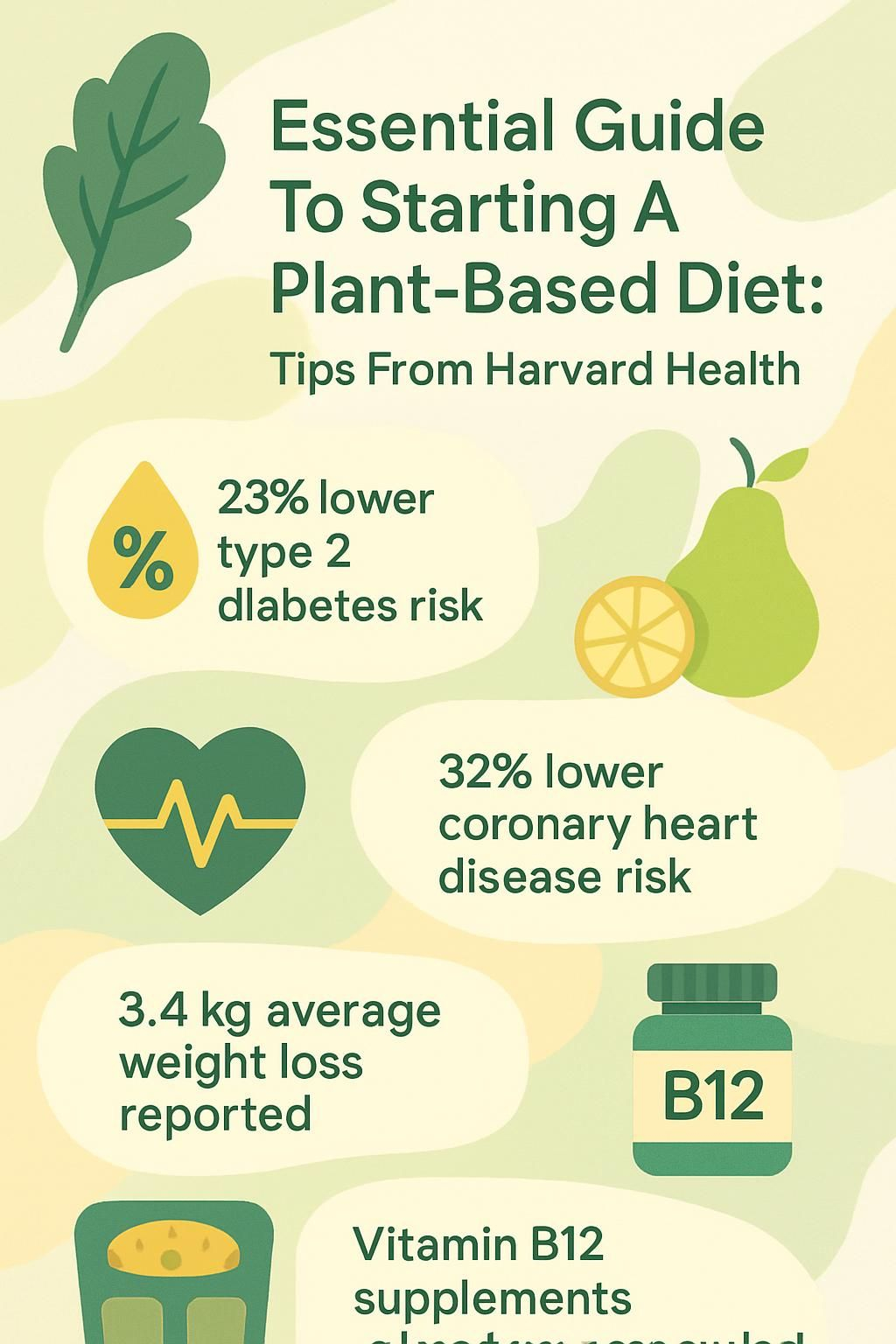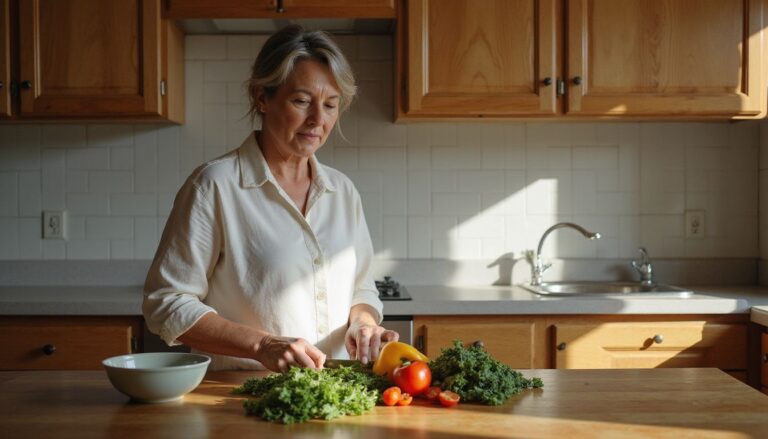Essential Guide To Starting A Plant-Based Diet: Tips From Harvard Health
Our Nutrition Assistant AI Suite will transform your body. You will lose fat, get toned, and build muscle. Gain confidence and optimal health.
Many people want to try a plant-based diet but do not know where to start. I felt the same way at first. Research from Harvard Health links plant-based eating with lower risk of heart disease, type 2 diabetes, and some cancers. The steps are simple once you know what to eat and how to plan.
This guide shares clear tips, quick swaps, and easy meal ideas. If you want better energy and simple food choices, you are in the right place.
Key Takeaways
- Harvard Health reports that a plant-based diet can lower type 2 diabetes risk by about 23% and coronary heart disease by up to 32%.
- People following plant-forward patterns lost an average of 3.4 kg in clinical trials and improved cholesterol, blood pressure, and weight control.
- Build meals around whole grains, legumes, nuts, seeds, fruits, and leafy greens. Limit highly processed foods for best results.
- Vitamin B12 from supplements or fortified foods is essential for strict vegans since unfortified plants lack this nutrient.
- Even one plant-based meal per day can reduce risk factors for chronic disease, based on recent Harvard findings.

What is a Plant-Based Diet?

A plant-based diet centers on foods that grow from the ground. I focus on fruits, vegetables, whole grains, nuts, and legumes. Some people follow a vegetarian or vegan pattern to get the benefits of plant-based eating.
What does a plant-based diet mean?
To follow a plant-based diet, I choose foods mostly from plants. That includes vegetables, fruits, whole grains, beans, lentils, peas, nuts, and seeds. I limit or avoid animal products such as meat, poultry, fish, eggs, and most dairy products.
There are different ways to eat plant-based. A vegan diet excludes all animal products. A vegetarian diet may include eggs or dairy. A flexitarian pattern is mostly plant foods with small amounts of animal foods at times.
Harvard Health reports that people who follow healthy plant-forward patterns have about a 23% lower risk of type 2 diabetes than those who eat fewer plant foods. After I shifted more of my meals to grains, beans, and greens, my weight held steady without feeling deprived. Swapping tofu for chicken in stir-fries made dinners simple and tasty.
What are the different types of plant-based diets: Vegan, Vegetarian, and Flexitarian?
Plant-based diets come in several styles. Here is how they differ and how I use them in everyday meals.
- Vegan diet excludes meat, eggs, dairy, honey, and seafood. Meals feature vegetables, legumes, nuts, and grains.
- Vegetarian diet avoids meat but includes eggs and dairy like milk, cheese, and yogurt. It offers flexibility while centering plants.
- Flexitarian diet focuses on plant foods yet allows occasional animal products. Most plates still feature grains, beans, fruits, and vegetables.
- Lacto-ovo-vegetarian eaters include both dairy and eggs, plus plant foods like leafy greens and whole grains.
- Flexitarian swaps often replace red meat with tofu, tempeh, or beans in scrambles, tacos, or pasta sauce.
- All three patterns work best when they limit highly processed foods and highlight whole plants to lower chronic disease risk.
- I began with one vegan meal each day, then moved to a fuller vegetarian routine. That slow shift helped me try new foods and build skills.
- With careful planning, you can get enough protein from legumes, whole grains, seeds, nuts, and soy foods like tofu and tempeh.
- Many people report better weight control and higher fiber intake on any of these plant-forward approaches.
Why Consider a Plant-Based Diet?
Choosing more plants can feel like giving your body a daily upgrade.
What are the health benefits of a plant-based diet?
Plant-based eating is linked to lower risk of heart disease, stroke, and certain cancers. People who follow this pattern tend to have better cholesterol and blood pressure. In clinical trials, adults assigned to plant-forward diets lost about 3.4 kilograms on average.
Whole grains, fruits, beans, leafy greens, nuts, and seeds deliver fiber and vitamins that support digestion and reduce inflammation. During a workplace Mediterranean diet challenge, I shifted my lunches to grain bowls and bean salads. Within weeks, my energy improved.
“Researchers found that participants following a healthy plant-based diet had up to a 32% lower risk of developing coronary heart disease.”
How does a plant-based diet impact the environment?
Eating mostly plants can lower greenhouse gas emissions. Livestock farming generates a large share of global emissions. Growing vegetables and grains generally uses less land, water, and fertilizer.
Analyses from Harvard-linked researchers suggest that wider plant-based eating could reduce land use for food by large margins. I noticed my grocery basket became greener after choosing whole foods over meat-heavy options. Less meat also means less pollution from animal waste and less clearing of land for feed crops.
Choosing minimally processed foods helps cut packaging waste. Fresh produce and bulk grains reduce plastic in the trash and the recycling bin.
What ethical reasons support choosing a plant-based diet?
Many people switch for animal welfare. Factory farms often keep animals in crowded conditions. That raises ethical and health concerns.
Building meals from vegetables, grains, beans, nuts, and seeds lowers demand for animal products. This shift also saves water and land. For me, eating more plants aligns with values like care for animals and care for the planet.
Key Components of a Plant-Based Diet
A strong plant-based plate is colorful, filling, and rich in fiber. Harvard sources highlight the core foods that support health and weight control.
Which vegetables and fruits should be included?
I aim for many colors each week. Different colors signal different nutrients. This simple rule keeps meals balanced and interesting.
- Leafy greens: spinach, kale, collards, and romaine are high in calcium, vitamin K, and antioxidants.
- Cruciferous vegetables: broccoli, Brussels sprouts, and cauliflower may help reduce colorectal cancer risk.
- Orange and yellow vegetables: carrots, sweet potatoes, and squash provide beta carotene for eye and immune health.
- Tomatoes and red peppers: rich in vitamin C and linked with better cardiovascular outcomes.
- Berries: blueberries, strawberries, raspberries, and blackberries supply antioxidants that ease inflammation.
- Seasonal fruits: apples, pears, grapes, citrus, and peaches add fiber for fullness with fewer calories.
- Avocados: source of potassium and monounsaturated fats, which support insulin sensitivity.
- Cruciferous greens: arugula and bok choy add peppery flavor and phytonutrients to salads and stir-fries.
- Snack fruits: bananas and kiwi provide steady carbs that support balanced blood sugar.
Filling half my plate with produce helps me hit fiber goals and enjoy variety without extra effort.
Why are whole grains important in a plant-based diet?
Whole grains like oatmeal, brown rice, quinoa, and whole wheat bread bring fiber, B vitamins, iron, magnesium, and antioxidants. Harvard data links higher whole grain intake with up to 30% lower risk of coronary artery disease.
Grains steady blood sugar and help with weight control. When I switched to brown rice, oats, and barley, I stayed full longer. A whole-food, plant-based pattern uses these grains as a core, which supports gut health and may reduce insulin resistance.
How do legumes and beans fit into this diet?
Grains give steady energy, and legumes add protein and minerals. Beans, lentils, peas, and chickpeas supply protein, iron, folate, and potassium.
One cup of black beans has about 15 grams of protein. Lentils pack folate for heart and brain health. I use chickpeas in salads or shape lentil patties for sandwiches. Diets with more legumes are linked with lower risk of diabetes and cardiovascular disease, based on cohort studies and clinical reviews.1
Mix different beans through the week for flavor, texture, and a stronger nutrient profile.
What role do nuts and seeds play in nutrition?
Nuts and seeds bring healthy fats, protein, and fiber. Almonds, walnuts, chia, flax, sunflower, hemp, and cashews offer vitamin E, magnesium, zinc, and plant omega-3s.
Harvard sources report that eating a handful of nuts several times a week is linked to lower heart disease rates. I add nuts and seeds to salads, oats, and yogurt alternatives for crunch and staying power. Vegans still need vitamin B12 from fortified foods or supplements, but nuts and seeds help fill gaps in minerals and antioxidants.
Benefits of a Plant-Based Diet
Plant-forward eating supports long-term health. The evidence ties it to better numbers and fewer chronic problems.
How does a plant-based diet reduce chronic disease risk?
Plant-based diets tend to lower LDL cholesterol, the “bad” type that raises heart risk. Leafy veggies, whole grains, and legumes also help manage blood pressure.
Across trials, people assigned to plant-forward diets lost more weight than those on other patterns. My own cholesterol improved after I built meals around beans, lentils, and nuts. Diets rich in fiber from fruits and whole grains are linked with up to 30% lower risk of major chronic diseases.2
Can a plant-based diet improve cardiovascular health?
Yes. Eating mostly plants can reduce LDL cholesterol and help control blood pressure. Studies show up to a 25% lower risk of heart disease among people who follow plant-based patterns.
Leafy greens, nuts, legumes, and whole grains support healthy arteries with fiber and antioxidants. After I borrowed ideas from the DASH diet, my blood work improved within three months. Harvard sources connect plant-heavy eating with better weight control and less inflammation.
Relevant Data Table: Cardiovascular Impact
| Food Group | Suggested Serving | Heart Benefit |
|---|---|---|
| Leafy Greens | 1–2 cups daily | Lower blood pressure and LDL |
| Whole Grains | 3 servings daily | Improved cholesterol |
| Beans and Legumes | At least weekly | Higher fiber intake |
| Nuts and Seeds | Small handful daily | Better lipid profile |
At restaurants, I choose grain bowls, wraps, or hearty salads. These swaps fit my goals without losing flavor.
How does it support weight management?
Plant-based meals have lots of fiber from leafy vegetables, beans, nuts, seeds, and fruits. Fiber helps me feel full longer, so I snack less.
Plant-forward diets often have fewer calories and less saturated fat than meat-heavy diets. In a Harvard-linked study, people lost more weight over 18 weeks on plant-based plans than on typical Western diets. Legumes and whole grains digest slowly, which steadies blood sugar and reduces cravings.
Why is it rich in essential nutrients and fiber?
Many plant foods are nutrient dense, meaning lots of nutrients for fewer calories. Lentils bring protein and iron. Spinach adds calcium and vitamin K. Berries deliver vitamin C and other antioxidants.
One cup of cooked black beans contains about 15 grams of fiber. Most adults need 25 to 34 grams each day. When I replaced refined carbs with greens, brown rice, and seeds, my digestion improved within weeks.
Common Challenges and How to Overcome Them
Starting can feel new, yet a few smart habits make it easier. These steps helped me get on track.
How can you get enough protein on a plant-based diet?
Plant foods offer plenty of protein. Good choices include beans, lentils, tofu, tempeh, whole grains, nuts, and seeds. A cup of cooked lentils has about 18 grams of protein; a cup of black beans has nearly 15 grams.
Soy foods like tofu and edamame work in stir-fries, soups, and bowls. Quinoa stands out among grains with about 8 grams per cup plus minerals and fiber. I boost smoothies with peanut or almond butter, and I toss chickpeas into salads. Varying sources across the day covers your amino acid needs without relying on powders.
What are good sources of vitamin B12 and omega-3 fatty acids?
I take vitamin B12 as a supplement because unfortified plant foods do not supply enough. Fortified cereals, nutritional yeast, and some soy or almond milks also provide B12. People on vegan or strict plant-based diets should use supplements or fortified foods often to meet daily needs.
For omega-3 fatty acids, I use ground flaxseed, chia, walnuts, and hemp seeds. These provide ALA, a plant omega-3 that the body can convert in small amounts. If I want EPA and DHA, I choose algae oil supplements, which are vegan sources of these fats.
How can you avoid processed plant-based foods?
I shop for whole foods first. Fresh or frozen vegetables and fruits, dry or canned beans, and whole grains become my base. I check labels and avoid added sugars, preservatives, and artificial flavors.
For example, I choose plain oats instead of instant packets high in sweeteners. I also cook simple meals. A fast pot of beans or a quick salad with leafy greens keeps processing low and nutrition high.
Tips for Transitioning to a Plant-Based Diet
Small steps stack up. A few daily changes can reset your routine in a week or two.
How do you start with one plant-based meal a day?
I choose one meal to make fully plant-based. Breakfast is easy. Oatmeal with berries and a handful of nuts is my go-to. Harvard research suggests even one plant-forward meal a day can lower risk factors for heart disease and type 2 diabetes.
For lunch, I build a bean salad or a grain bowl with brown rice and vegetables. Swapping meat for lentils or chickpeas adds protein and fiber.
What are ways to gradually add more whole foods?
I make small swaps during the week. I add spinach or collards to pasta or soups. I trade white rice for brown rice or quinoa. For snacks, I pick nuts, seeds, hummus, or fruit instead of bars.
Each shopping trip, I try one new vegetable or grain. Oatmeal beats sugary cereal for fiber and steady energy. A helpful target is half a plate of vegetables at lunch and dinner.
How can you experiment with plant-based recipes?
I replace animal proteins with lentils, tofu, or beans in familiar dishes. Quinoa or farro mixed with legumes adds texture and nutrients. I aim for colorful veggies in every recipe to raise vitamin and mineral content.
For dessert, I use nuts, seeds, or fruit purees instead of dairy or eggs. Blended cashews make sauces and fillings creamy with less saturated fat. Trying new produce like collard greens keeps food fun and diverse.
What are effective meal planning tips for success?
I pick a few simple, balanced meals for the week. Each includes a whole grain, a legume, vegetables, and nuts or seeds. I batch-cook quinoa, chickpeas, and brown rice to save time.
A short grocery list based on my menu keeps me focused and helps me skip processed items. For protein, I plan dishes with lentils or tofu several times a week. Quick snacks like carrots with hummus or fruit with nut butter help me stay on track.
Foods to Include and Avoid
What you add matters as much as what you limit. Strong choices make this pattern easy to keep.
Which foods should you emphasize in a plant-based diet?
I build meals around nutrient-dense foods that deliver fiber, vitamins, minerals, and plant protein.
- Colorful vegetables like collards, spinach, carrots, and bell peppers supply key vitamins and minerals.
- Whole fruits such as berries, apples, oranges, and bananas add natural sweetness and antioxidants.
- Whole grains including oats, brown rice, quinoa, barley, and bulgur provide steady energy and fiber.
- Legumes like lentils, chickpeas, black beans, and soybeans deliver protein and minerals such as iron and magnesium.
- Nuts and seeds including walnuts, chia, sunflower, flax, and almonds add healthy fats and important micronutrients.
- Soy foods like tofu and tempeh boost variety and support protein needs, even in a flexitarian plan.
- Leafy greens like kale and collards help maintain calcium for bone health when dairy is limited.
- Minimally processed foods protect the nutrient value of your meals.
- Fresh herbs such as basil and cilantro add flavor with almost no calories.
These choices align with evidence linking plant-forward diets to better cardiovascular health and improved mood markers.
What foods should you limit or avoid?
Limiting low-nutrient foods helps you get the most from a plant-based diet. I use this checklist while shopping and meal planning.
- Processed snacks and baked goods; they are often high in sugar, sodium, and unhealthy fats.
- Refined grains like white bread and white rice; they lack fiber and key nutrients.
- Sugary drinks, including soda and sweetened teas; these add empty calories.
- Processed plant-based meats, which may contain excess salt, additives, and saturated fat.
- Salty condiments such as soy sauce and ketchup; high sodium is linked to hypertension.3
- Fried foods; frying raises calories and can create harmful fats linked with heart risk.4
- Desserts with lots of added sugar; high sugar intake raises the risk of chronic disease.5
At first, I craved snack foods. Keeping fresh fruit or a small handful of nuts nearby helped me avoid the vending machine.
Harvard Health Tips for Success
Variety, whole foods, and steady tracking keep this simple and sustainable.
How can you focus on variety and balance?
I fill my meals with foods from every plant group. My sample plate includes whole grains, leafy greens, beans or lentils, and a daily serving of nuts or seeds. I keep things colorful since each hue brings unique nutrients. Oranges give vitamin C while spinach gives iron.
Diverse choices improve coverage across protein, fiber, and minerals. I rotate legumes, seeds, vegetables, and grains through the week to avoid ruts.
Why choose minimally processed foods?
Minimally processed foods keep more vitamins, minerals, and fiber. Whole fruits, vegetables, nuts, beans, and simple grains often beat packaged snacks on nutrition.
Harvard sources connect whole plant foods with lower risk of heart disease and diabetes. Swapping brown rice for white rice boosts fiber at every meal.
How do you monitor nutrient intake effectively?
I use a food diary or app to track meals and snacks. Then I compare my intake to guidelines from Harvard and the Dietary Guidelines for Americans. Each week, I scan for protein, vitamin B12, iron, calcium, and omega-3s.
If I see a gap, I add fortified foods or consider a supplement. Reading labels helps me check fiber and sodium. Tracking portions shows trends and keeps my plan balanced.
Sample Plant-Based Meal Plan
A simple plan removes guesswork. It also helps me hit nutrition targets day after day.
What is a healthy plant-based breakfast option?
Oatmeal with berries, chia seeds, and unsweetened almond milk is a strong breakfast. One cup of cooked oats provides about 6 grams of protein and 4 grams of fiber. Chia seeds add plant omega-3s. Berries bring antioxidants and vitamin C.
I often prepare overnight oats with rolled oats, soy milk, sliced banana, ground flaxseed, and walnuts. Whole grain breakfasts can improve cholesterol and steady morning energy.
What does a balanced plant-based lunch look like?
My lunch includes a whole grain like quinoa or brown rice for steady energy. I pile on colorful vegetables such as spinach, peppers, carrots, and tomatoes.
For protein, I use chickpeas, black beans, or tofu. A half-cup of cooked beans supplies about 7 to 9 grams of protein. I add avocado slices or a few walnuts or pumpkin seeds for healthy fats. A drizzle of olive oil adds flavor and fat-soluble vitamins.
What are good dinner choices on a plant-based diet?
For dinner, I often make a grain bowl with brown rice, quinoa, or farro. I add roasted vegetables like broccoli, sweet potatoes, and Brussels sprouts. Black beans or lentils bring protein, and a sprinkle of hemp seeds adds healthy fats.
Quick stir-fries with tofu or tempeh are great on busy nights. Whole wheat or chickpea pasta with a tomato sauce and spinach also works well.
What snacks fit well with plant-based eating?
Sliced apples with almond butter gives fiber and vitamin E. Whole grain crackers with hummus deliver protein and complex carbs. Roasted chickpeas offer plant protein and iron.
Carrot sticks with guacamole add potassium and monounsaturated fats. Plain popcorn delivers fiber. A small handful of mixed nuts helps with magnesium and keeps me full between meals.
Debunking Myths About Plant-Based Diets
Misconceptions are common. A few facts make the path much clearer.
Is a plant-based diet really expensive?
It does not have to be. Staples like dry beans, lentils, rice, oats, and frozen vegetables usually cost less than meat or cheese. Harvard sources note dried beans are a very affordable protein. USDA data show a pound of dry lentils often costs far less than a pound of ground beef.
Cooking with seasonal produce and skipping pricey processed vegan items keeps costs low. Planning meals around grains and legumes saves money and supports heart health.
Can you get enough protein from plants?
Yes. Lentils, beans, tofu, tempeh, quinoa, peas, and nuts all have meaningful protein. One cup of cooked lentils has about 18 grams. A half-cup of tofu has around 10 grams. Most adults need about 46 to 56 grams per day, based on age and sex.
Eating a mix of plant proteins across the day covers essential amino acids. Many athletes do well on this approach.
Are plant-based diets boring?
No. Spices, herbs, and sauces can turn simple ingredients into bold meals. Cuisines from India, Thailand, Mexico, and the Mediterranean offer hundreds of plant-based dishes.
One of my favorites is three-bean chili with peppers, corn, smoked paprika, and cumin. It beats many meat versions I have tried. Variety across grains, vegetables, fruits, nuts, and seeds keeps meals exciting and nutritious.
Long-Term Benefits of a Plant-Based Diet
Over time, the gains add up for both your body and the planet.
How does a plant-based diet improve health and energy?
Plant foods fuel me with slow-burning carbs and fiber. That means steadier energy without big crashes. Vitamins such as B6, C, E, folate, and minerals like magnesium support metabolism and oxygen flow.
Harvard sources link plant-based diets to lower rates of obesity, type 2 diabetes, heart disease, and high blood pressure. Eating less saturated fat from animal products can improve cholesterol by up to 10%. I noticed better focus and lighter afternoons once I built my meals around plants.
Does it lower the risk of major chronic diseases?
Yes. Studies connect plant-based eating with lower risk of heart disease, type 2 diabetes, and some cancers. People who eat more fruits, vegetables, whole grains, nuts, and legumes show less inflammation and better blood pressure control.
Large studies also report fewer strokes and heart attacks among people who favor plants. As I shifted my meals, my yearly checkups improved.
What positive effects does it have on the planet?
Plant-based diets can reduce greenhouse gas emissions and use less land and water. Growing beans, grains, and vegetables generally needs fewer resources than raising animals for food.
At home, I noticed less packaging waste once I bought more produce and bulk items. These small changes support healthier soil, cleaner water, and stronger ecosystems.
Conclusion
A plant-based diet offers lasting health, environmental, and ethical gains. Harvard Health highlights how small daily choices can lead to big results. With variety, balance, and whole foods, anyone can start and succeed.
I aim for progress, not perfection. Pick one meal, try one new grain or bean, and build from there. This content is for education only and does not replace medical advice. If you have a health condition or take medication, consult a healthcare professional before major diet changes.
Sources: Harvard Health Publishing; Harvard T.H. Chan School of Public Health; Satija A., et al., Journal of the American College of Cardiology, 2017; American Heart Association; USDA Economic Research Service, 2023.
FAQs
1. What are the main benefits of starting a plant-based diet according to Harvard Health?
A plant-based diet can lower the risk of heart disease, type 2 diabetes, and certain cancers. Studies from Harvard Health show that eating more fruits, vegetables, whole grains, and legumes supports better weight control and improved cholesterol levels.
2. How do I get enough protein on a plant-based diet?
You can meet your protein needs with foods like beans, lentils, tofu, tempeh, nuts, seeds, and whole grains. Research shows these foods provide all essential amino acids when eaten in varied combinations throughout the day.
3. Are there nutrients I might miss on a plant-based plan?
Some people may need extra vitamin B12 since it is not found in plants. Iron and calcium are also important; you can find them in leafy greens or fortified products. A registered nutritionist or doctor may suggest supplements if needed for complete nutrition.
4. What practical steps help make switching to a plant-based diet easier?
Start by adding more vegetables and whole grains to each meal while reducing animal products gradually over several weeks. Planning meals ahead helps maintain variety and balance; this approach made my own transition smoother as I learned new recipes one step at a time.
Summary:
Choosing a plant-focused eating pattern offers health advantages supported by research from trusted sources such as Harvard Health. Meeting nutrient needs requires careful food choices but is achievable through planning and guidance from professionals if necessary.







